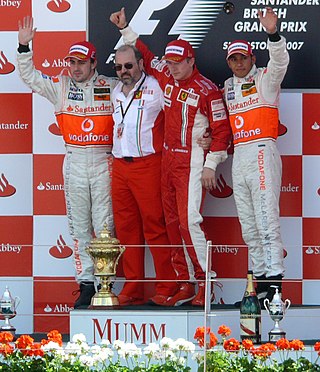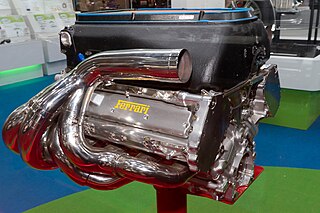Paolo Martinelli | |
|---|---|
| Born | 29 September 1952 |
| Nationality | |
Paolo Martinelli (born 29 September 1952) is an Italian engineer best known for his position as head of Scuderia Ferrari's Engine Department from 1994 to 2006.
Paolo Martinelli | |
|---|---|
| Born | 29 September 1952 |
| Nationality | |
Paolo Martinelli (born 29 September 1952) is an Italian engineer best known for his position as head of Scuderia Ferrari's Engine Department from 1994 to 2006.
Born in Modena, Martinelli studied mechanical engineering at Bologna University, graduating in 1978. He joined Ferrari immediately, at first working on engine design for the company's production cars. In 1994, he was appointed head of the Formula One team's Engine Department, where he decided to ditch the commitment to running V12 engines in favour of V10s. The first V10-powered Ferrari raced in 1996, and the team used this configuration to win five Drivers' and six Constructors' Championships before rules were brought in stipulating the use of V8s for 2006. Martinelli's favorite race was the 2000 Japanese Grand Prix at Suzuka which Michael Schumacher won in a Ferrari. [1] In October 2006, Martinelli moved to an executive role within Fiat, Ferrari's parent company. [2] His position in Ferrari was taken over by Gilles Simon. [3]

Alain Marie Pascal Prost is a French former racing driver and motorsport executive, who competed in Formula One from 1980 to 1993. Nicknamed "The Professor", Prost won four Formula One World Drivers' Championship titles and—at the time of his retirement—held the records for most wins (51), fastest laps (41), and podium finishes (106).

Larrousse Formula One was a motorsports racing team founded in 1987 by Didier Calmels and former racer Gérard Larrousse, originally under the name Larrousse & Calmels. It was based in Antony, in the southern suburbs of Paris. It was renamed Larrousse after the departure of Calmels following his murder of his wife. The team competed in Formula One from 1987 to 1994 before succumbing to financial problems, scoring a best finish of third at the 1990 Japanese Grand Prix during this time.
Aldo Costa is an Italian engineer and the Chief Technical Officer at Dallara. With 14 constructors' championships and 12 drivers' titles working for Ferrari and Mercedes, Costa is one of the most successful engineers and designers in F1 history.

The Ferrari F2005 is a Formula One racing car used by Ferrari for the 2005 Formula One World Championship. The chassis was designed by Rory Byrne, Ignazio Lunetta, Aldo Costa, Marco Fainello, John Iley and Marco de Luca with Ross Brawn playing a vital role in leading the production of the car as the team's Technical Director and Paolo Martinelli assisted by Giles Simon leading the engine design and operations.

The Ferrari 248 F1 is a Formula One car, used by Ferrari for the 2006 season. The chassis was designed by Rory Byrne, Simone Resta, Aldo Costa, Tiziano Battistini, Marco Fainello, John Iley and Marco de Luca with Ross Brawn playing a vital role in leading the production of the car as the team's Technical Director and Paolo Martinelli assisted by Giles Simon leading the engine design and operations.

The Ferrari F2002 was a racing car used by Scuderia Ferrari Marlboro as its entry for competition in the 2002 Formula One season. The chassis was designed by Rory Byrne, Ignazio Lunetta, Aldo Costa, Marco Fainello, Nikolas Tombazis and James Allison and Paolo Martinelli, assisted by Giles Simon leading the engine design and operations, under the overall leadership of Ross Brawn who was the team's Technical Director and Jean Todt the team Manager. It won fifteen Grands Prix, from a total of nineteen races in 2002 and 2003. It is widely regarded as one of the most successful Formula One car designs of all time, as Michael Schumacher drove it to a then record-equaling fifth world drivers' title in 2002, while easily clinching the 2002 constructors' title with as many points as all other teams put together.

The Ferrari F2001 was a highly successful Formula One car that the Ferrari team competed with for the 2001 Formula One season. The chassis was designed by Rory Byrne, Ignazio Lunetta, Aldo Costa, Marco Fainello, Nikolas Tombazis and James Allison with Ross Brawn playing a vital role in leading the production of the car as the team's Technical Director and Paolo Martinelli assisted by Giles Simon leading the engine design and operations.

The Ferrari F1-2000 was the Formula One racing car with which the Ferrari team competed in the 2000 Formula One World Championship.

Mauro Forghieri was an Italian mechanical engineer, best known for his work as a Formula One racing car designer with Scuderia Ferrari during the 1960s and 1970s. He is credited with introducing the first designed rear wings to Formula One at the 1968 Belgian Grand Prix. He oversaw numerous technical developments during his tenure at Ferrari, including the creation of the 250 GTO and P-series sports racing cars, the Ferrari flat-12 series of engines, Ferrari's first turbocharged engine in the 126 C F1 car, and a prototype semi-automatic transmission in 1979. During Forghieri's tenure with Ferrari, the company won the F1 World Driver's Championship four times and the F1 World Constructors' Championship seven times. After leaving Ferrari in 1987, he worked at Lamborghini and Bugatti then founded the Oral Engineering Group in 1995.

The Ferrari F399 was the car with which the Ferrari team competed in the 1999 Formula One World Championship. The chassis was designed by Rory Byrne, Giorgio Ascanelli, Aldo Costa, Marco Fainello, Willem Toet, and Nikolas Tombazis, with Ross Brawn playing a vital role in leading the production of the car as the team's technical director and Paolo Martinelli assisted by Giles Simon leading the engine design and operations.

The Ferrari F300 was a Formula One car that the Ferrari team competed with for the 1998 Formula One World Championship. The chassis was designed by Rory Byrne, Giorgio Ascanelli, Aldo Costa, Willem Toet, and Nikolas Tombazis, with Ross Brawn playing a vital role in leading the production of the car as the team's technical director and Paolo Martinelli assisted by Giles Simon leading the engine design and operations. It was powered by the 3-litre Ferrari Tipo 047 V10 engine and designed around a narrower track as mandated by the FIA in a series of regulation changes for that season.

The Ferrari F2003-GA was a highly successful car used by Scuderia Ferrari in the 2003 Formula One World Championship. The chassis was designed by Rory Byrne, Ignazio Lunetta, Aldo Costa, Marco Fainello, Nikolas Tombazis and James Allison with Ross Brawn playing a vital role in leading the production of the car as the team's Technical Director and Paolo Martinelli assisted by Giles Simon leading the engine design and operations. Its development was based on the previous Ferrari F2002, but featured new bulbous sidepods and a lengthened wheelbase to aid aerodynamics. The engine and gearbox were developed versions of the previous model.

Gilles Simon is a French Formula One engineer and designer.

Carlo Chiti was an Italian racing car and engine designer best known for his long association with Alfa Romeo's racing department. He also worked for Ferrari and was involved in the design of the Ferrari 156 Sharknose car, with which Phil Hill won the 1961 championship.

Cesare Fiorio is a former Formula One sporting director for Ferrari, Ligier and Minardi, and former team manager of Lancia's factory World Rally Championship team. He is currently employed as a TV commentator. His son Alessandro "Alex" Fiorio became a professional rally driver.

Enrique Hector Scalabroni is an Argentinian race car designer, technical director, and team racing boss. He was employed by Dallara, Williams, Ferrari, Lotus and Peugeot Sport between 1985 and 2002, before setting up his own F3000 and GP2 team in 2003, BCN Competicion, which lasted till the end of 2008.

Mattia Binotto is a Swiss-Italian motorsport engineer. Formerly the team principal of Scuderia Ferrari in Formula One from 2019 to 2022, he has been the chief operating officer (COO) and chief technical officer (CTO) of Sauber Motorsport since 1 August 2024.
The Grand Prix racing history of Scuderia Ferrari dates back to 1947. The team is the most successful team in the history of Formula One racing, having contested every World Championship season since 1950, winning 15 Drivers' Championships and 16 Constructors' Championships.

Ferrari manufactured a series of 3.0-litre, naturally-aspirated, V10 racing engines, exclusively for their Formula One race cars; between 1996 and 2005. They chose a V10 engine configuration, because it offered the best compromise between power and fuel efficiency; the V12 was powerful but thirsty while the V8 was weaker but economical. They switched to 2.4-litre naturally-aspirated V8 engine configuration for 2006. Over its decade-long evolution, power levels varied; from 715 hp @ 15,500 rpm in 1996, to over 900 horsepower, around 935 hp @ 19,000 rpm, toward the end of the 2005 season. The Tipo 05 series of engines, produced between 2001 and 2005, was officially stated to produce between 825 hp @ 17,800 rpm, and 865 hp @ 18,300 rpm. In qualifying mode, however, these engine were reputed to develop up to, or at times over, 900 horsepower (670 kW) at 19,000 rpm.

Ferrari has manufactured three naturally-aspirated V8 racing engines, designed for Formula One racing. First, the Tipo DS50 engine introduced in 1956; with the 2.5 L engine configuration. Second, the Tipo 205/B engine, introduced in 1964; with the 1.5 L engine configuration; and was designed by Franco Rocchi and Angelo Bellei. Then, a 42-year hiatus; until the FIA imposed a 2.4 L engine V8 configuration for all Formula One teams in 2006, with Ferrari introducing their Tipo 056; designed by Gilles Simon.